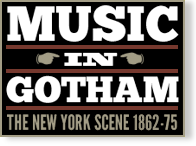“The Thomas orchestra gave their last matinée of the season on Saturday, at Steinway Hall, to an audience of only moderate dimensions. The following admirable programme was presented [see above].
Of the principal features in this selection the foremost, of course, was the exquisite posthumous fragment of Schubert’s. Since it was first made know to America by Theodore Thomas, more than six years ago, it has grown steadily into the heart of the public, and the orchestra in the mean time has grown into a more and more perfect comprehension of its inmost beauties. There are very few compositions to which the band gives such a deeply poetical interpretation, and very few with which it so easily stirs the feelings. The Hungarian Suite by Hoffmann was next in interest to the Symphony. It bears strong national characteristics, being founded, we should judge, on Hungarian Volkslieder and their related dance melodies. The first movement, ‘In the Coronation Hall,’ is a richly colored allegro, in which it is not difficult to imagine the strains of the popular chorus and the progress of a gorgeous procession. The Romanza is a beautiful melody, the first part of which is borne by the ‘celli, and the second by a solo clarinet, the same theme being then pursued by these two instruments as a duet, with embellishments by the other reeds. The third movement, ‘In the Puszta,’ is the most striking. The Puszta in Hungary is a treeless heath-grown region on the banks of the Theiss, where a strange patriotic race of herdsmen and horse-raisers roams over the sandy steppes. Among these wild and fiery people is heard the national song, with its strong, abrupt rhythms, and the curious Hungarian dances are the characteristic amusements of the popular gatherings. These, we suppose, are indicated in the vigorous opening allegro, while the splendid presto that follows seems to depict the rushing of horsemen over the storm-swept plain. The movement closes with a recurrence of the principal theme of the Kronungssaal.
The Bach concerto was first played at one of the symphony concerts, when it instantly captivated the audience, as we have known Bach’s music to do on many a memorable occasion. The first and third movements are dance measures, such as occur in the old-fashioned Suites, and are written for violins in four parts and violoncelli. They are given by Mr. Thomas with four instruments in each part and one contrabasso additional, to reinforce the ‘celli. It is the second movement only which corresponds to the modern concerto. Mr. Listemann there plays a solo violin, while the other first violins are silent and the accompaniment is furnished by a double string quartet, again reinforced by a contrabasso.
The other instrumental selections, the superb Schumann overture, the ‘Rienzi’ Ballet, and Mr. Lockwood’s harp solo, were all excellent, and were generally relished. Mr. Whitney gave (in English) two of the six songs which Beethoven wrote to Gellert’s religious poems, and made an excellent impression both for himself and for Mr. Pease, by his delivery of the Bedouin Love Song, the composer accompanying him on the piano.”

